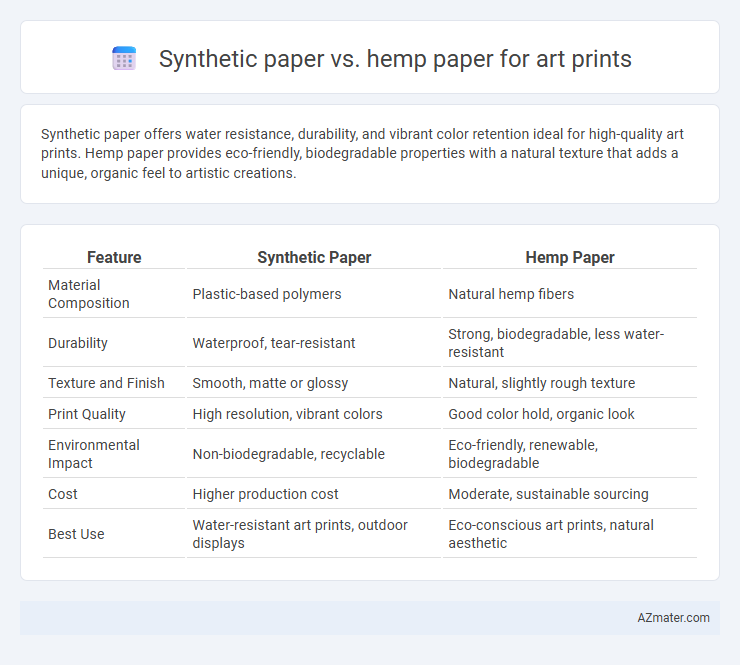Synthetic paper offers water resistance, durability, and vibrant color retention ideal for high-quality art prints. Hemp paper provides eco-friendly, biodegradable properties with a natural texture that adds a unique, organic feel to artistic creations.
Table of Comparison
| Feature | Synthetic Paper | Hemp Paper |
|---|---|---|
| Material Composition | Plastic-based polymers | Natural hemp fibers |
| Durability | Waterproof, tear-resistant | Strong, biodegradable, less water-resistant |
| Texture and Finish | Smooth, matte or glossy | Natural, slightly rough texture |
| Print Quality | High resolution, vibrant colors | Good color hold, organic look |
| Environmental Impact | Non-biodegradable, recyclable | Eco-friendly, renewable, biodegradable |
| Cost | Higher production cost | Moderate, sustainable sourcing |
| Best Use | Water-resistant art prints, outdoor displays | Eco-conscious art prints, natural aesthetic |
Introduction to Art Printing Materials
Synthetic paper offers waterproof and tear-resistant qualities, making it ideal for high-durability art prints with vibrant colors and sharp details. Hemp paper, derived from sustainable and eco-friendly fibers, provides a textured surface that enhances the natural appearance of prints and appeals to environmentally conscious artists. Choosing between synthetic and hemp paper depends on factors like desired print longevity, environmental impact, and the specific visual effect sought in art printing.
What is Synthetic Paper?
Synthetic paper is a durable, tear-resistant material made from plastic polymers such as polypropylene, designed to mimic the texture and appearance of traditional paper while offering water resistance and longevity. It provides vibrant color reproduction and smooth printing surfaces ideal for high-quality art prints, especially in environments prone to moisture or handling. Unlike hemp paper, synthetic paper does not degrade easily, ensuring that art prints maintain their integrity and vividness over time.
What is Hemp Paper?
Hemp paper is crafted from the fibers of the hemp plant, known for its durability, eco-friendliness, and resistance to yellowing, making it an excellent choice for high-quality art prints. Its natural texture enhances the depth and vibrancy of printed images, offering a unique tactile experience compared to synthetic paper. The sustainable cultivation of hemp plants contributes to its appeal among environmentally conscious artists seeking renewable materials for their artwork.
Material Composition and Sustainability
Synthetic paper consists mainly of polypropylene or polyethylene, offering water resistance and durability ideal for long-lasting art prints, while hemp paper is made from hemp fibers known for their natural strength and eco-friendly properties. Hemp paper production requires less water and fewer chemicals than synthetic alternatives, significantly reducing environmental impact and contributing to sustainability. Choosing hemp paper supports renewable resources and biodegradability, whereas synthetic paper excels in longevity but presents recyclability challenges.
Print Quality: Color Vibrancy and Detail
Synthetic paper offers superior print quality for art prints, delivering enhanced color vibrancy and sharp detail due to its smooth, non-absorbent surface that prevents ink bleed and allows for precise color layering. Hemp paper, though environmentally sustainable, tends to have a coarser texture that can slightly diffuse ink, resulting in softer color edges and less saturation. Artists seeking vivid, detailed reproductions often prefer synthetic paper for its consistent, high-definition finish that highlights intricate designs and vibrant hues.
Durability and Longevity
Synthetic paper offers exceptional durability and longevity for art prints due to its tear-resistant, waterproof, and fade-resistant properties, making it ideal for long-term display. Hemp paper, known for its natural fiber strength and resistance to deterioration, also provides considerable durability but may be more susceptible to environmental factors like moisture and UV exposure. For archival-quality art prints, synthetic paper generally ensures superior preservation and consistent appearance over time compared to hemp paper.
Eco-Friendliness and Environmental Impact
Synthetic paper offers durability and water resistance but relies heavily on petroleum-based materials, leading to higher carbon emissions and limited biodegradability compared to hemp paper. Hemp paper is highly eco-friendly, featuring rapid growth cycles, minimal pesticide use, and full biodegradability, making it an excellent sustainable choice for art prints. Choosing hemp paper reduces environmental impact through lower resource consumption and enhanced recyclability without compromising print quality.
Cost Comparison and Availability
Synthetic paper typically costs more than hemp paper due to its specialized manufacturing process involving plastic resins and additives designed for durability and water resistance. Hemp paper benefits from a growing availability driven by sustainable farming practices and often presents a cost-effective option, particularly in regions with established hemp cultivation. While synthetic paper is widely available through specialized suppliers, hemp paper availability is increasing as demand for eco-friendly art print materials rises in the market.
Suitability for Different Art Styles
Synthetic paper offers a smooth, water-resistant surface ideal for vivid inkjet prints, making it highly suitable for detailed digital art and vibrant graphic designs. Hemp paper, with its natural texture and durability, excels in traditional art styles such as charcoal, pencil, and mixed media, providing an organic feel and enhanced texture to the artwork. Artists must consider the medium and desired aesthetic, as synthetic paper enhances color precision and sharpness, while hemp paper supports tactile expression and eco-friendly art production.
Making the Best Choice for Art Prints
Synthetic paper offers exceptional durability, waterproof qualities, and bright, consistent color reproduction, making it ideal for high-quality art prints that require longevity and resistance to fading. Hemp paper provides a sustainable, eco-friendly option with a unique texture and natural fiber composition, enhancing the tactile and aesthetic appeal of art prints for environmentally conscious artists. Choosing the best paper depends on the desired balance between durability, print vibrancy, environmental impact, and the specific artistic effect sought in the final print.

Infographic: Synthetic paper vs Hemp paper for Art print
 azmater.com
azmater.com